Khadas VIM4 is a compact Amlogic A311D2 octa-core Cortex-A73/A53 SBC with 8GB RAM, HDMI input and output, WiFI 6 connectivity, and more. You can check our earlier post for the full specifications. The good news is that it will officially launch on May 10.
I’ve also just received a Khadas VIM4 review sample today together with accessories. Today, I’ll start by checking out the board, assembling the kit, and trying out OOWOW services to boot OS from the cloud, before testing available operating systems in more detail in the second part of Khadas VIM4 review a little later.
Khadas VIM4 kit unboxing
I received everything in a blank cardboard package with several small packages inside.
Besides Khadas VIM4 SBC, we’ve got a plastic + metal enclosure with screws and screwdriver, two antennas for WiFi and Bluetooth, a USB Type-C power supply, a USB-C cable, an M.2 expansion board, a short 4-wire cable for power (optional), and a Quick Start Guide.
Contrary to some other SBCs limited to 5V input, Khadas FC57 is a proper USB PD power supply with 5V/3A, 9V/2.67A, and 12V/2A charging.
The Quick Start Guide provides a description of the board, instructions to assemble the antennas and connect peripherals, as well as instructions to get started with OOWOW embedded services to install operating systems from the Cloud, and links to hardware documentation and firmware.
Just like the previous generation Khadas VIM3, VIM4 adopts a low profile RJ45 jack for Ethernet, USB 3.0 ports, HDMI, and a USB Type-C port. It is cooled by a large, yet, thin, heatsink and fan combo that came pre-installed, and covers all main components.
On the back of the board, we can see the 4-pin connector for 9V-20V DC input next to the microSD card socket. The bottom comes with display connectors (VByOne and MIPI DSI), and two MIPI CSI connectors for cameras. There’s also an M.2 NVMe socket, but no mounting thread.
M.2 Expansion board assembly
That’s when the M.2 expansion board becomes useful.
I first had to loosen the screws holding the heatsink in place, before insertion the expansion board, and putting the screws back in place. It provides two M.2 sockets. one for an M.2 NVMe 2280 SSD, and the other for an M.2 2242 modem together with a nano-SIM card slot.
That’s all nice, but it won’t fit in the case I have received.
Khadas VIM4 enclosure assembly
So let’s remove it, and install the antennas as described in the Quick Start Guide. The long antenna to connector A, and the short “U” antenna to connector B.
We can now somewhat easily insert the board into the enclosure which does not appear to be made for VIM4, since there’s no opening for the micro HDMI input port, and I had to trim the small antenna to lock it into place against the enclosure side as shown below. [Update: Khadas confirmed the “DIY Case Gen1” does not fit VIM4 that well, and they are working on a “DIY Case 2: for VIM4, but it won’t be ready for the May 10 launch”]
Sadly, I think I damaged the connector from the small antenna, and it won’t go into connector B anymore. It got detached several times while trying to clip the antenna to the plastic enclosure. The last step was to tighten the four long screws provided with the enclosure.
As you may see from the photo above, it does not seem to fit perfectly with some gaps at the top and the top cover is “curved”. More worryingly, I was unable to insert the USB-C cable… So I disassembled it and realized I had made a mistake. I should have removed the four screws from the bottom holding the heatsink, like we did when installing the M.2 expansion, placed the board inside the enclosure, and attached the board to it from the top using the same screws.
Now, everything is properly aligned.
As a side note, it’s possible to access the GPIO header by removing a cover on the top. It can be put back into place once you’re done.
First boot with OOWOW
Let’s connect the power supply, USB RF dongles for a mouse and a keyboard, as well as HDMI to see what happens upon the first boot:
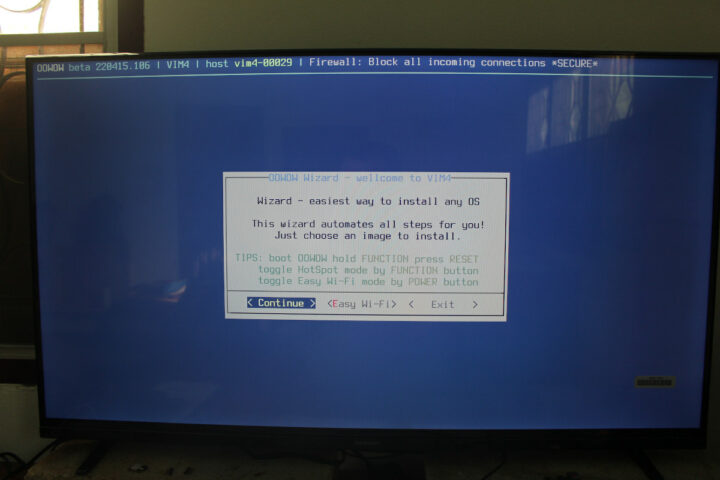
That’s the OOWOW wizard to install OS from the cloud. I set up WiFi since I don’t have easy access to Ethernet right now, and then selected “Continue”.
We can select Android 11, Ubuntu 20.04 GNOME, Ubuntu 20.04 Server, or Ubuntu 22.04 GNOME, all to be installed to the eMMC flash. Since I’m on a cellular data plan with limited speed, I selected the server image to try it out.
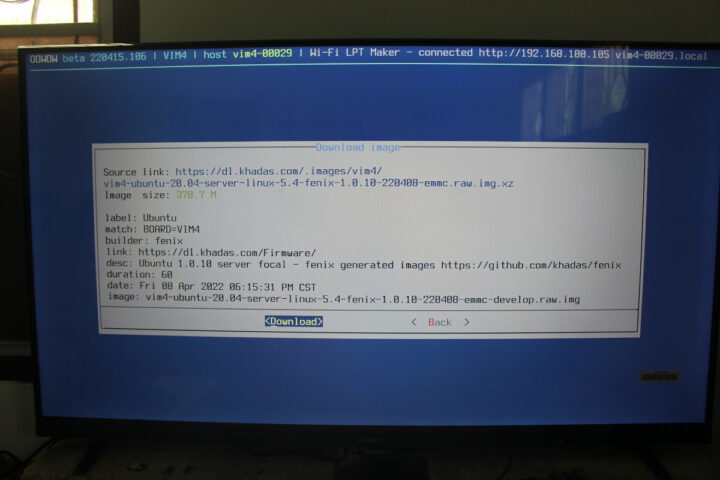
The download started fine… That’s a good start.
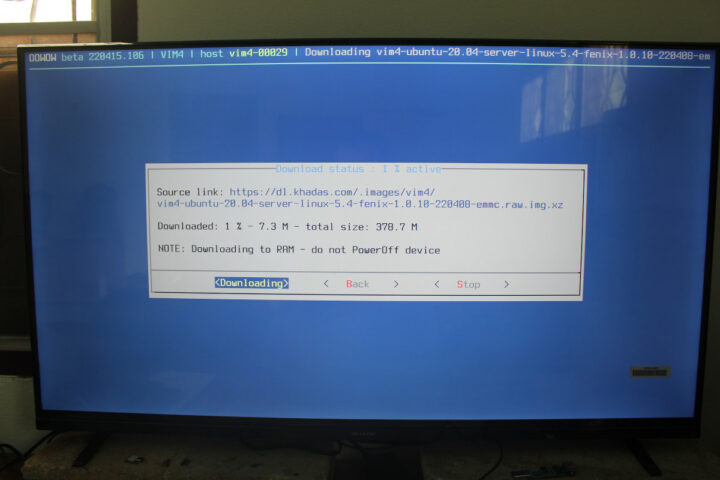
After several minutes the download was complete, so I selected “Install”.
Now we can reboot to launch Ubuntu 20.04 server…
That ‘s really convenient, easy, and similar to Raspberry Pi Network Install. There are just a few problems. The server image does not output anything to HDMI, and OOWOW does not copy the WiFi configuration data to the image, so I have no network access either. I’ll have to set up a local network and/or use a serial console, but I’ll do that a little later since time is running out for today.
I’d like to thank Khadas for sending the Khadas VIM4 board for review. The launch is scheduled for May 10, at which point the price will also be revealed, and you can register your interest on Khadas website.
Continue reading
- Khadas VIM4 Review – Part 2: Android 11 preview and benchmarks.
- Khadas VIM4 SBC review – Part 3: Ubuntu 22.04

Jean-Luc started CNX Software in 2010 as a part-time endeavor, before quitting his job as a software engineering manager, and starting to write daily news, and reviews full time later in 2011.
Support CNX Software! Donate via cryptocurrencies, become a Patron on Patreon, or purchase goods on Amazon or Aliexpress


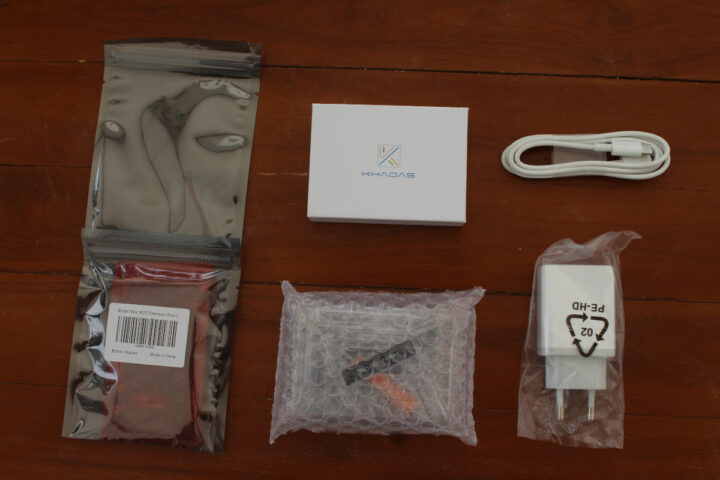
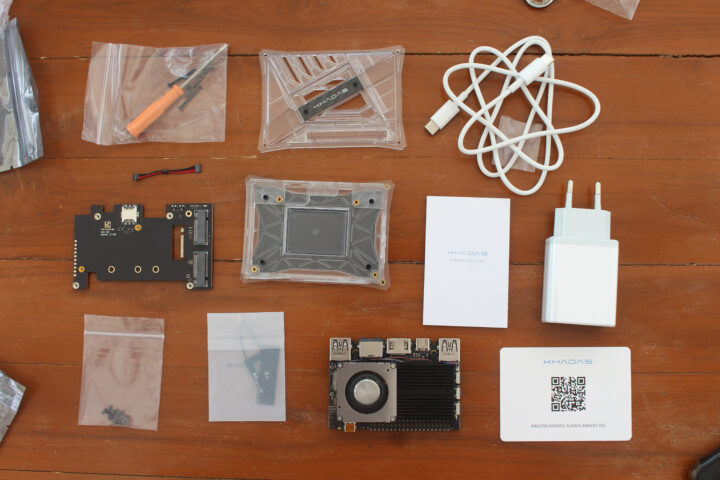
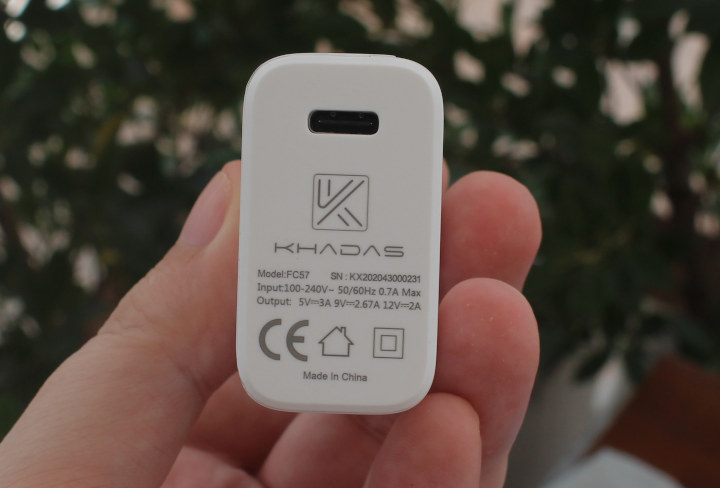
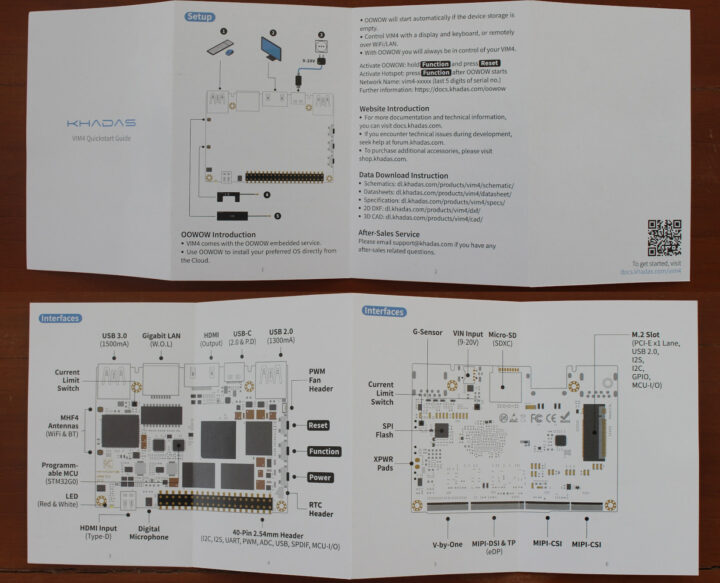
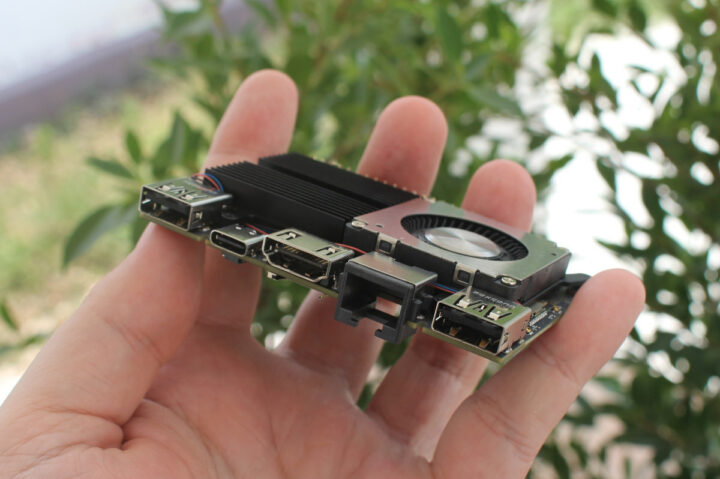
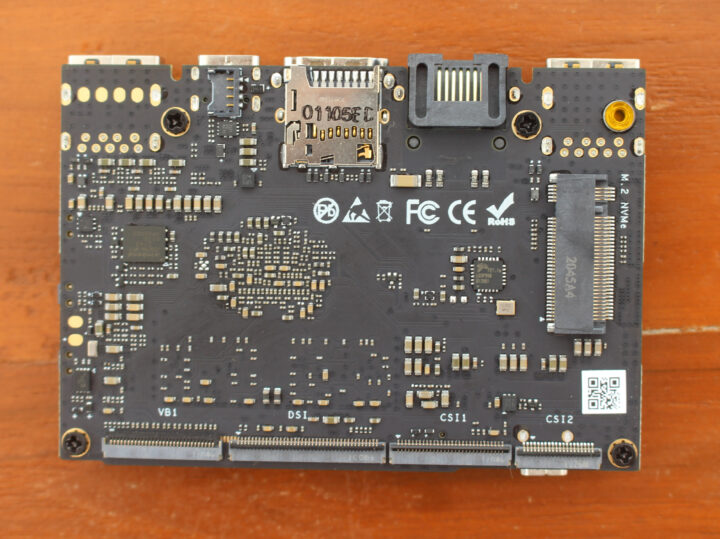
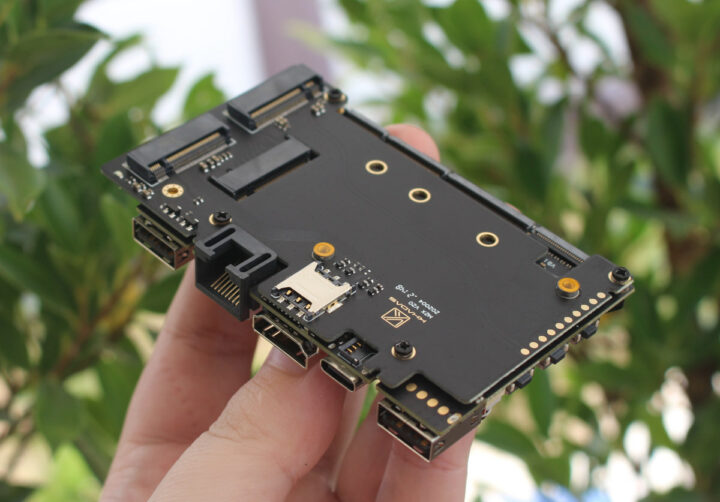
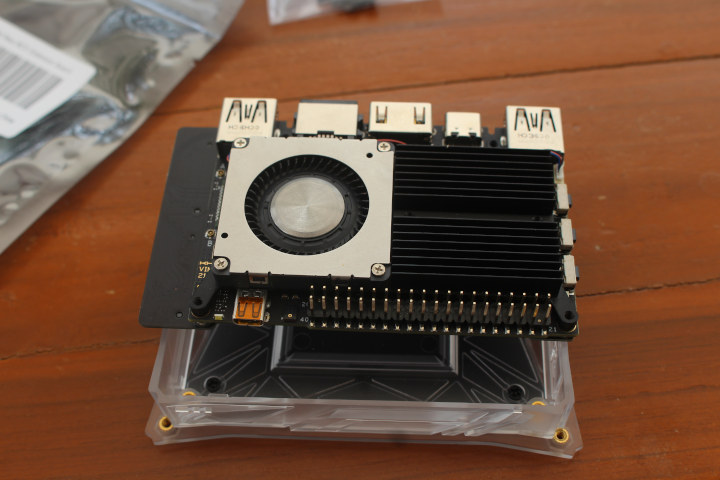
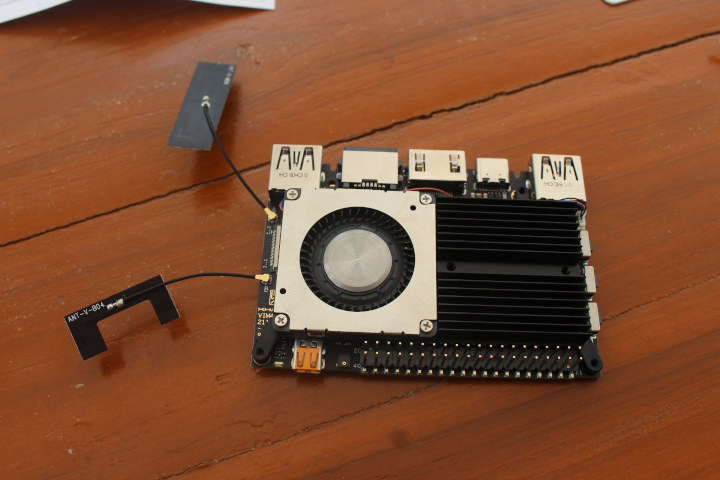
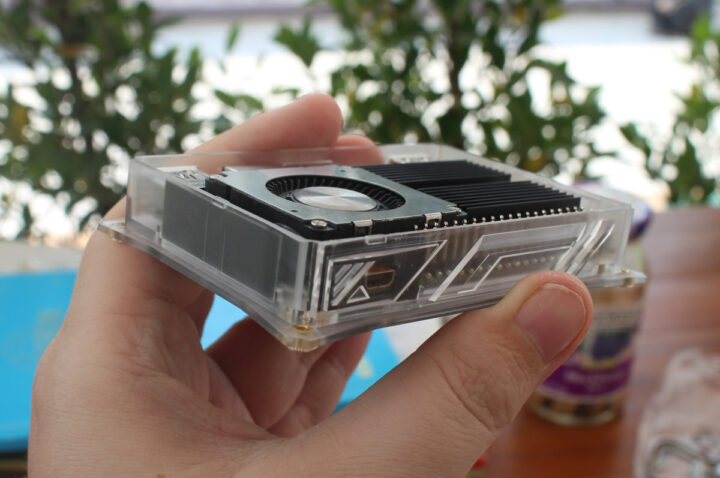
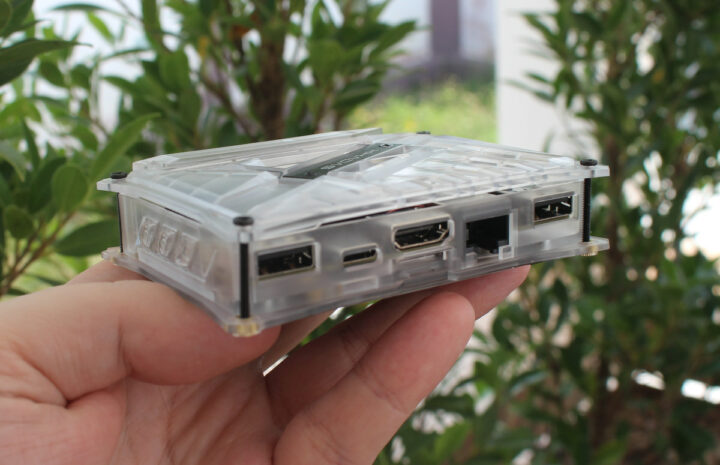
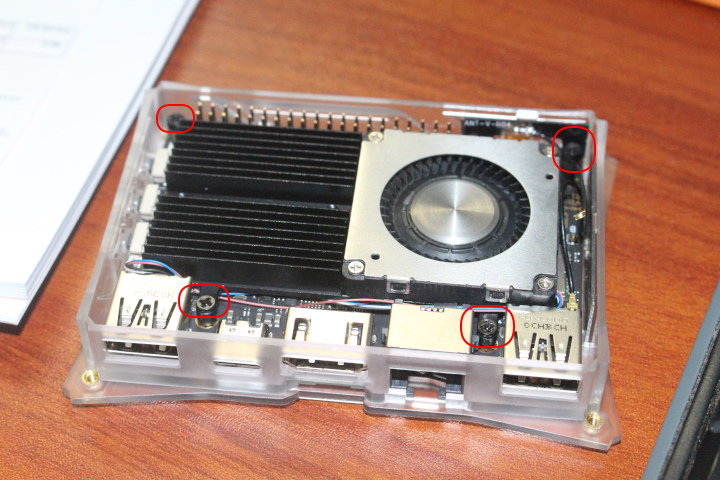
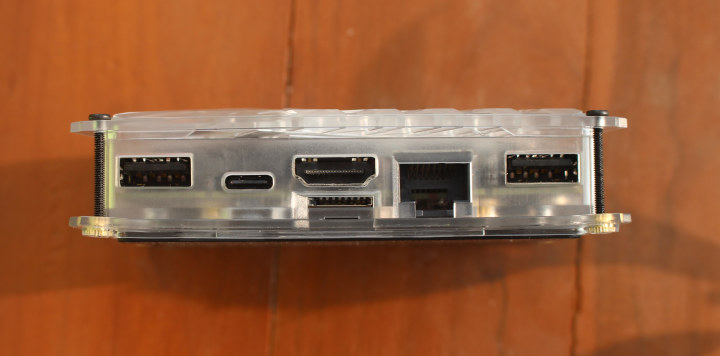
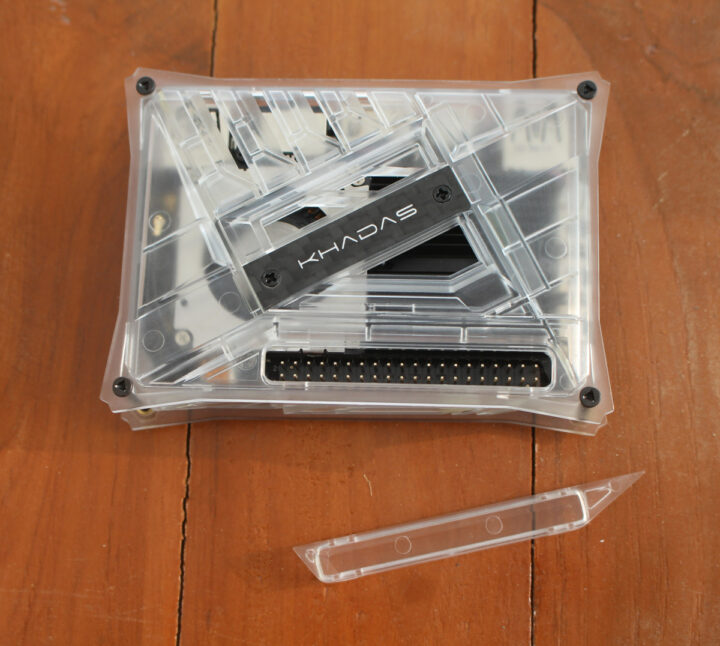
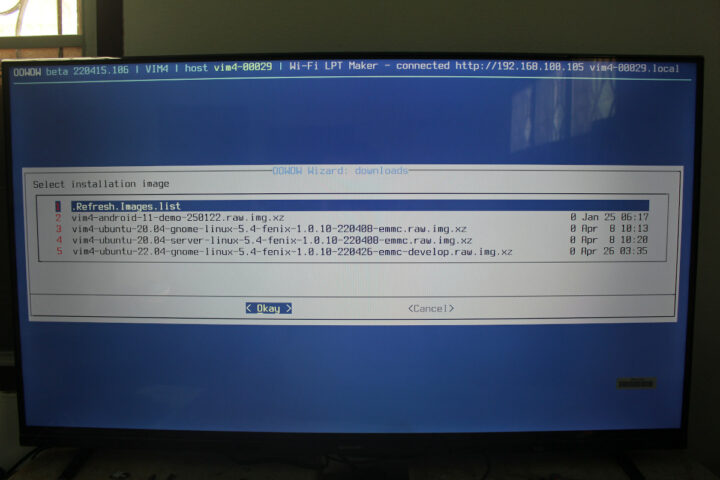
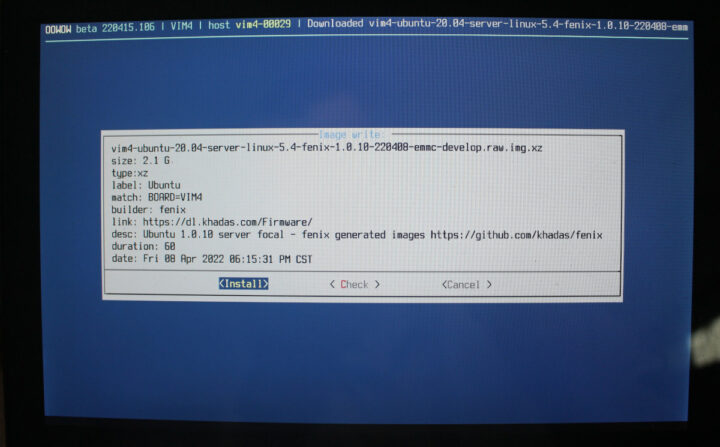
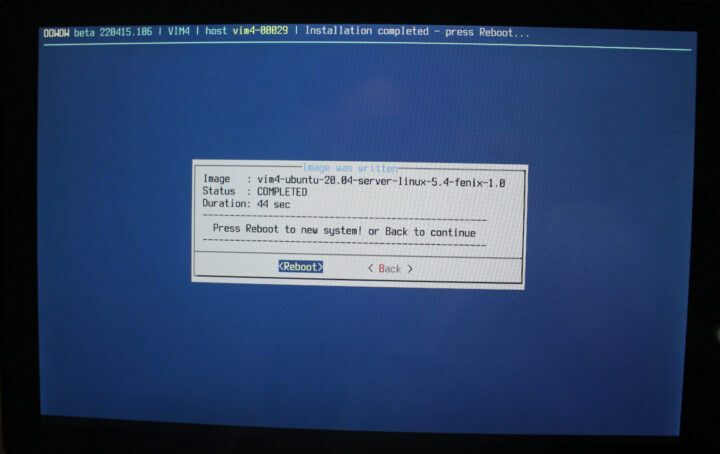



Just read this refreshing comment wrt Amlogic BSP driver support. 🙂
And I would believe once VIM4 pricing is revealed any potential A311D2 enthusiasm maybe present in the ‘SBC community’ might vanish anyway…
The Khadas Vim3 is supposed to be an Android reference board… Surely they could do better.
But as it goes, once again I made the mistake of expecting even anything from their latest and greatest board.
That’s the first thing to come to mind when reading the above review; I’ve said plenty of times before that the software-situation with ARM-based boards is a god awful pile of horse manure and I continue to be proven right.
Nice to see online videos of Vim4 running real world programs the Rpi4 and RK3588 struggle with. Much better than pretend benchmarks.
I’m going to be repetitive now, but like the RK3588 this board won’t be competitive with Jasper Lake either. Unlike the 3588 it at least should have a lower idle wattage. For those who put value on saving 1W when idling…
There are some videos on YouTube showing the actual performance of the RK3588 and it is undoubtedly a far more powerful SOC than this, which is essentially an S922X+.
The VIM3 Pro is $159.90, so I would not expect the 4 to be much cheaper, if at all.
They still can’t add M.2 on the board itself either, which adds to the cost for an addon board.
I’m going for the ROCK5 Model B over this any and every day.
The S905X is what AML fans are waiting for and this release might indicate that it isn’t coming any time soon. The S905X4 never gained any attraction with the open source community either and so AMLogic seem very much on the back foot.
We can only hope that Rockchip and their approved vendors do not screw up their gaping market opportunity.
> The VIM3 Pro is $159.90, so I would not expect the 4 to be much cheaper, if at all.
Cheaper? This was a good one! You realized that VIM4 is equipped with 8 GB RAM?
> We can only hope that Rockchip and their approved vendors do not screw up their gaping market opportunity.
As if any ‘Android e-waste’ SoC vendor would care about or even notice this ‘SBC community’ and its desire for proper Linux support…
I’ve just been told Amlogic A311D2 chip alone sells for $38.
So most probably still equipped with a NPU and if the use case in question can make use of the excellent media capabilities maybe worth the price…
Already wondering whether Hardkernel will do an ODROID-N2.5 🙂
Initial Vim4 do not have NPU going off Khadas forum post.
Not exactly, some of rockchip engineers visit this community everyday. We are working on modern Linux kernel support and RK356X/3588 5.10 kernel is on the way.
Topton M6 N5105 8GB 128GB nvme better value.
I’m disappointed that they still haven’t provided a case for the VIM3/VIM4 that can accommodate the M.2 expansion board. I haven’t found a 3rd party alternative either.
Maybe this one?
https://forum.khadas.com/t/case-for-the-vim3-and-m2x/6753/7
https://forum.khadas.com/t/case-for-the-vim3-and-m2x/6753/280
I am not a fan of clear cases either. Why are so many cases so ugly. This is meant to go near your TV right?
That’s one benefit of making them yourself ( https://github.com/wtarreau/sbc-cases ) but it requires some hardware and more importantly, takes an amazingly long time to take the precise measurements and test them. However once done it’s rewarding.
You can buy other cases, not sure any Vim4 yet.
KKSB Khadas VIM3 Case
Go radical, spray paint the case 😁😇
There is SBC Case Builder (https://github.com/hominoids/SBC_Case_Builder) that may work for some as well. It’s driven by SBC Model Framework (https://github.com/hominoids/SBC_Model_Framework). I’m trying to get as many SBC in the framework as possible to use for autonomous case generation.
I’m no longer supporting companies that give me the message …
“Your browser is no longer supported”
… on their web-site.
I’m afraid once Khadas reveals its Vim4 pricing information, my wish to buy it along others will vanish away. Anything closer to $200 for an ARM SBC board instead of $100 is just crazy, considering accessories are need it besides shipping and importing tax fees(30% in most countries) that could easily driven this baby in the $300 ball park price tag.
$200 could be acceptable for an ARM SBC with desktop-class performance and some accessories included (case, power supply). But it has to bring a lot to the table to counter better supported and likely more powerful x86 options.
The Rock5 Model B is around the sweet spot, but only with the $50 discount, and you will have to resign yourself to a world of OS/software fail vs. x86.
> desktop class performance
You long for the Core 2 Quad days again?
Based on the Passmark for Q6600, most of what I use is around that or worse.
If you can get something like these: https://liliputing.com/2022/04/this-fanless-mini-pc-with-intel-jasper-lake-sells-for-155-and-up.html for $155, then $200 is not that acceptable.
Unless you’re Apple 😀
That has no memory, storage, no OS or import tax.
€164 for the Celeron in the Netherlands (includes tax), €209 for the Pentium. Actually €7 less with the code…
Let’s not act like the Arm (barebones) boards with similar performance are going to be cheaper anytime soon.
> no OS
You’re conveniently leaving out the fact that Arm has no software 😉
Big PLUS for M.2 expansion board
Can the VIM4 be used with a single USB-C cable plugged into a modern monitor? I.e accepting both PD and DP (and maybe USB 2 / 3.1 from a built in hub) via the same port?
The manual says nope. USB-C still only for DC-IN and USB OTG. Also check VIM4 main article with full specs (link ‘hidden’ in 1st sentence of this blog post which seems to be inivislbe to many readers).
Well now there is a VS-A311D2 Android smart motherboard / coreboard out there. 4GB ram. Nice to see more products.